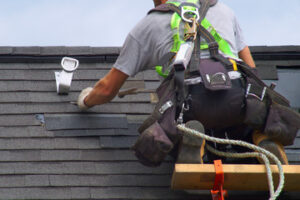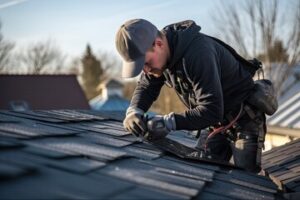A roof replacement is a significant investment that helps your house stay safe, comfortable and dependable. It’s also a way to protect your home value and keep it competitive with other homes on the market.

Surface repairs and replacing flashing, the thin metal pieces that prevent leaks around features like chimneys and skylights, are easy enough for most roofing contractors to handle. But if you have leaks or other damage that needs to be repaired, it’s time for a new roof. For more information, visit https://www.ellingsonroofing.com/roofing-helena-mt.
A few missing shingles are probably the first sign of roof damage, but there may be other indicators such as leaks or water stains on ceilings and walls. A poorly ventilated attic can cause the shingles to dry out and curl up at their ends, while weather such as high winds or hail can damage shingle surface areas. Additionally, critters scurrying around the roof can damage shingles by scratching them or digging up loose granules.
While the visual clues of damaged shingles are usually the most obvious, you can also check for signs of a problem by climbing onto your roof (remember to wear proper safety equipment) and carefully inspecting. In addition to missing shingles, look for cracked and curled shingles as well as loose granules.
If you do find a damaged shingle, the first step is to remove it and replace it with a new one. This is a relatively easy job if you’re comfortable working on a roof. Start by assessing the damage and gathering your supplies: A ladder, safety harness, gloves, hammer, pry bar, roofing nails, and a utility knife. You’ll also want to have some roofing cement to seal the replacement shingle.
To remove a damaged shingle, first use the pry bar to lift the shingle’s tabs and expose the nails underneath. Remove the nails and pull out the shingle. Once the area is clear, slide a 3-tab shingle into place and nail it down with 4 roofing nails. Secure the shingle with a dab of roofing cement under each of its edges.
Once the replacement shingles are in place, you can nail down any remaining nails and cover them with more roofing cement to create a watertight seal. If you notice additional shingles that are damaged, repeat the process to repair those as well.
Cracking shingles are generally caused by a combination of factors, such as high winds or temperature changes. They can also be a result of drying out or shrinking over time, which causes the shingle to crack and change shape. When this happens, the cracks can allow moisture to seep into the home. Regardless of the cause, these cracks should be repaired promptly to prevent moisture from entering your home.
Leaking Gutters
Leaking gutters can be a serious problem for homeowners. When left unchecked, they can cause water damage to the siding of the house, the foundation, and even the landscaping around the home. A leaking gutter can also indicate that the roof needs repair or replacement. Gutter leaks can occur for a variety of reasons, and it is important to take the time to find out what is causing them.
If your gutters are leaking due to an improper slope on the roof, it may be a simple matter of hiring a local roofing contractor to adjust the pitch. This can help to prevent future leaks from occurring.
It is also possible that your gutters are leaking due to debris being clogged in the downspouts. This can also be a fairly easy fix by cleaning out the gutters and downspouts. If you have a downspout that has come loose, this is a more complicated fix that may require professional help. If you are concerned about safety when climbing on a ladder to access your gutters, you may want to consider hiring a professional to do this task for you.
Over time, the fasteners that secure a gutter to the fascia board on a home can become loose, which can shift the gutter and prevent it from draining correctly. Fortunately, this is also a problem that can often be easily fixed by simply re-screwing the gutter to the fascia board with a drill.
Gutters are designed to be angled slightly downward to help them carry away rainwater and avoid overflowing. If your gutters are not angled properly, they can begin to sag and pull away from the home, leading to water damage and stains. Additionally, water that pools in the gutter can speed up corrosion and create rust, which can lead to holes in the gutters.
While replacing your gutters can be a costly and time-consuming option, repairing the damaged sections of your gutters with roof and gutter sealant is a cheaper alternative that will likely work just as well. You will need to clean the damaged section of your gutter, then scrape out any rust or old caulk and wire-brush it thoroughly to ensure that you have a smooth surface on which to apply the sealant.
Roof Leaks
A leaky roof that goes ignored over time can lead to water damage and mold inside the home. This damage can impact other behind-the-scene parts of the house as well, including drywall and other building materials. To find the source of a leak, you’ll want to look for water stains in the ceiling and trace them back.
Dark spots on the interior walls may indicate a leak in the attic or crawlspace, while spots on exterior walls could point to a problem with step flashing where the roof meets the wall. This flashing can become loose and deteriorate over time, causing rainwater to seep through and stain the wall.
To check for a roof leak, first use a flashlight to examine the underside of your roof sheathing or rafters. You’ll also want to inspect for signs of a leak, such as rotting wood or dark mold growth. If the rafter bays are insulated, you can also check the insulation for wet areas.
You can also use a ladder to get onto the roof and look for the source of the leak. You can start by tracing the water stains on the ceiling to their source, which will likely be a damaged shingle or exposed fastener. Once you’ve found the spot, you can mark it with a piece of chalk or paint to identify it to the roofers.
If you don’t have access to the attic or crawlspace, you can try to create a barrier to stop the water from reaching the ceiling. You can lay a sheet of plywood across the joists and place a bucket beneath it to catch the dripping water. You’ll need to go up and empty the bucket regularly, otherwise it will fill up quickly and break through the drywall.
For a more permanent solution, you can use tar paper to patch up the leaky spot on the roof. This will provide a temporary fix until you can call in a professional to make permanent repairs. The most important thing is to spot the problem early on and take action before it becomes worse. If you notice any water stains on the ceiling or musty odors in your home, it’s time to contact your local roofing professionals for help.
Aesthetics
There are a number of different reasons why people choose to have their roof replaced. Functionality is one of those reasons, but aesthetics can also be an important factor. Many homeowners opt to replace a roof for cosmetic reasons, such as wanting their home to look more modern or having neighbors that have done so. Others might want to improve the aesthetics of their home in order to sell it or attract tenants.
Aesthetics is the study of beauty and taste. It is often confused with the philosophy of art, but it is much broader than that. The term is derived from the Greek word aisthetikos, which means “of or for perception by the senses.” While it was initially used to discuss the nature of art, Immanuel Kant’s work, Critique of Judgment, solidified the notion that aesthetics are more than the philosophy of art.
Unlike science, which studies the material world, aesthetics studies experiences in that world. It is about the pleasures that we get from certain experiences, and how they can affect our attitudes and beliefs. It is also about the subjective, emotional, and irrational aspects of our responses to the world. It is about the fact that our reactions are influenced by our culture and society, which is why it’s sometimes difficult to separate them from our innate responses.
One of the things that makes it so difficult to define aesthetics is the fact that there are many different ways in which we can experience the world. It is possible, for instance, to be happy in a country with no natural beauty and yet find the environment there pleasant. It is also the case that our definitions of what is beautiful and unpleasant change over time. Victorians, for example, tended to see African sculptures as ugly, while Edwardian audiences saw the same sculptures as beautiful.
In modern times, it has become popular for people to create blogs around specific aesthetics. These are usually a collection of photos that are arranged to form a coherent theme and express an attitude. For example, there are blogs about cottagecore, gothic, and preppy aesthetics. Some of these websites are part of Tumblr, while others have their own unique domains.
